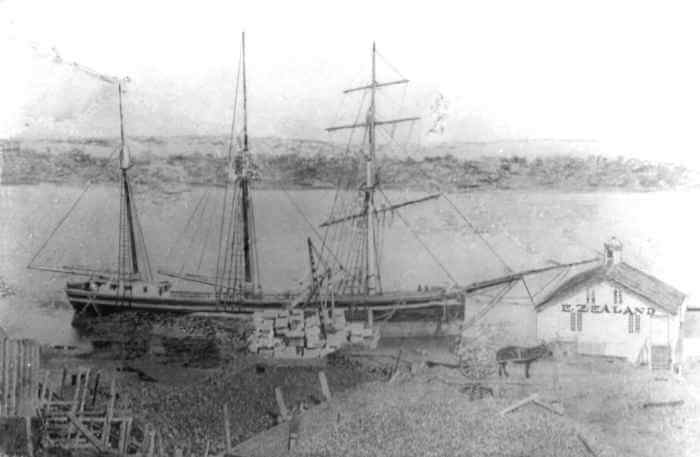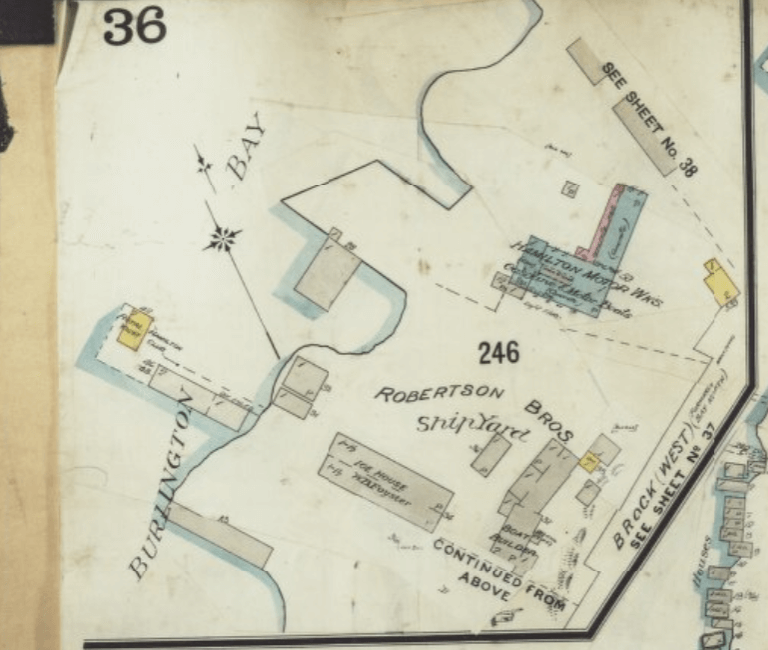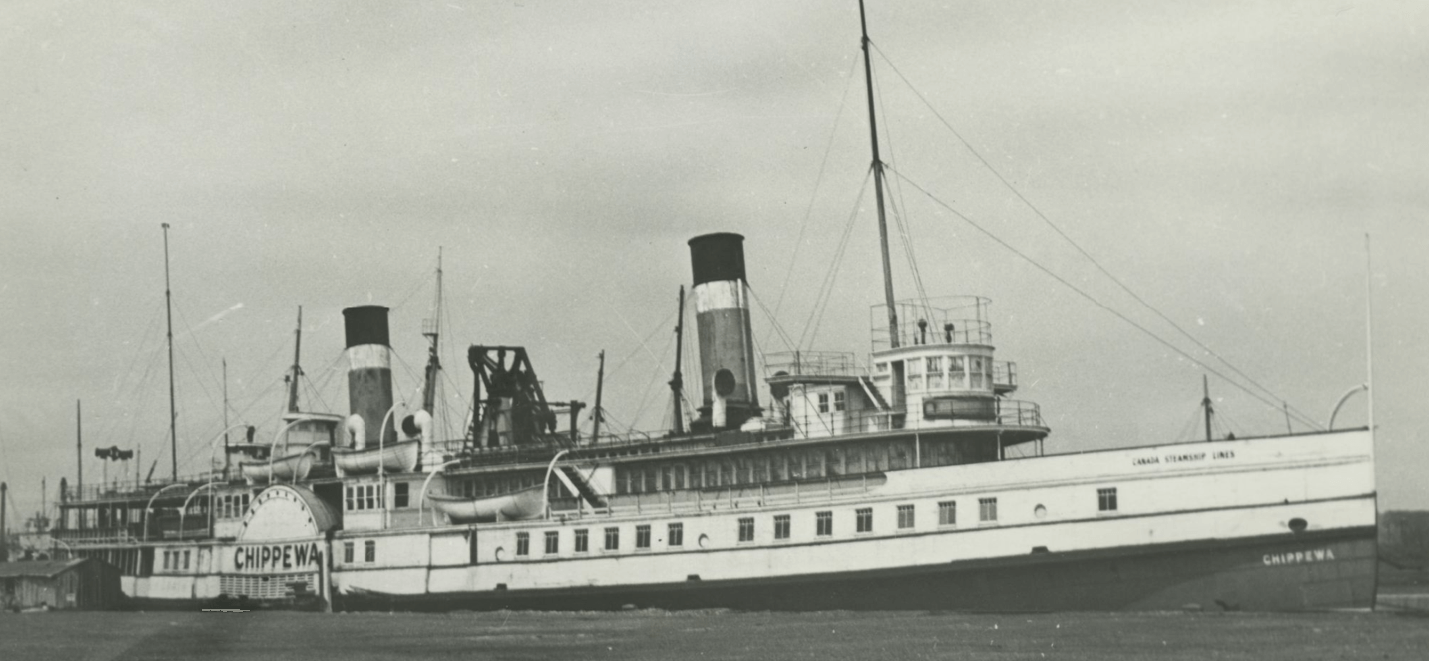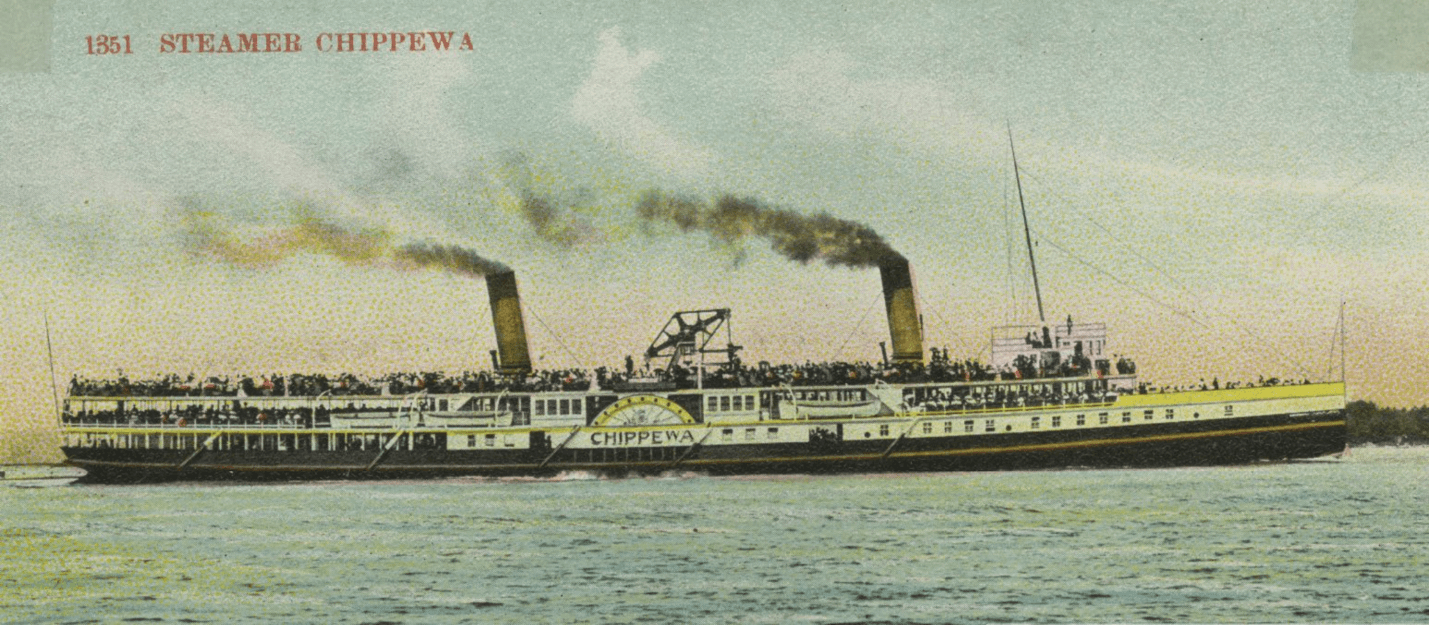Sailcloth and Steel
The Working Life of a 19th Century Hamilton Built Ship
Kyle Timmins
Hamilton - 2022
Vessel construction has been an integral facet of Great Lakes history, and few settlements along the shores of Lake Ontario can lay claim to playing a role equal to that of Hamilton. Since the beginning of modern settlement, vessels of all shapes, sizes, and designs have come of the slips into the green waters of the bay, influencing not only the economic history of the Hamilton area but the entire province.1 This paper will explore the importance of Hamilton’s connection to the shipbuilding industry and how many of the vessels commissioned along its shores played a central role in the development of the Great Lakes cultural and economic landscape. This assessment will be achieved by analyzing the shipbuilding industry in Hamilton, its technological prowess and ability to produce reliable working vessels through reconstructing the career of one of Hamilton’s most significant vessels, the Chippewa. The shipbuilding industry of Hamilton played a central role in the economic development of the Great Lakes by providing technologically advanced working vessels for transportation and commerce.
Hamilton’s connection to the development of Great Lakes shipping and transportation begins in 1832 when a modern and sensibly sized canal, known as The Burlington Bay Canal, was constructed on the eastern side of The Bay.2 With the canal’s completion, the city’s port would develop rapidly seeing the construction of various coastal businesses such as grain elevators, coal loaders, and of most interest to the development of Great Lakes vessel construction, shipyards.3 These early shipyards which included Robertson’s, The Hamilton Bridge Company’s and the Burlington Bay Dock and Shipbuilding Company were involved in constructing many of the foremost lake faring vessels of the period.4 These builders often employed new technology and methods in vessel construction, ones which would have a lasting effect upon the economic and social landscape of Lake Ontario.5 Innovations such as the introduction of slimmer designed vessels and composite hulls allowed for ships of higher speed and navigation abilities to be introduced into the region. Hamilton made significant technological contributions to Great Lakes shipbuilding industry, with many of its shipyards adopting new cutting-edge technology integral to the advancement of navigation on the inland seas.

Figure 1: Wilderness Shipbuilding Robertson’s Shipyard on Zealand’s Wharf, 1870s
Robertson’s Shipyard was among the first formal shipbuilding businesses established on The Bay.6 Founded in the 1860s by shipwright Archibald Robertson and his sons, the shipyard operated without major interruption until its closure in the 1890s.7 The shipyard was located at Zealand’s Wharf on the southern side of the bay, as the century’s technology progressed so too did the shipyard.8 A photograph from 1873 (Figure 1) and an insurance map from 1898 (Figure 2) display this progression as the shipyard transitioned from a collection of sheds in the spirit of Canadian “wilderness shipbuilding” to a modern 19th century yard.9 This progression would yield a great deal of working ships from the 1863 schooner Hercules to newer steam vessels like The Canada, completed in 1872. 10 Vessels built at Robertson’s were often on the cutting edge of marine technology leading in many ways the advancement of travel and commerce on the Great Lakes. Exemplifying Hamilton’s technological importance on the lakes was the steam freighter Acadia commissioned by local Captain John Malcolmson and completed by Robertson in 1867. The Acadia was a 135.8-foot steam vessel that was outfitted with a state-of-the-art boilers and engine system, and an impressive hull.11 The Acadia is believed to be the first vessel to sport a composite hull on the Great Lakes a method which blended both steel and woodwork to create a durable but thin ship hull that prioritized speed and cargo space. This technological progression allowed for greater ease of maneuverability and speed for steam ships.12 The Acadia would go on to have a steady career hauling lumber and lighthouse equipment, and was a harbinger of Great Lakes navigational technology.13

Figure 2: Advancement of the Yard Insurance Plan of the City of Hamilton, Ontario
Hamilton’s role in the technological advancement of Great Lakes vessels was by no means limited to one shipbuilder or advancement such as the introduction of composite hulls. Many of the foremost ship contractors of the bay continued to press the advancement of engineering and design. The Hamilton Bridge Company was founded in the early 1890s as a corporation focused primarily upon the engineering of steel bridges utilizing the blossoming steel fabrication industry of Hamilton as its economic base.14 The company would also foray into the construction of vessels, particularly steam vessels.15 The vessels constructed by the company at its shipyard were primarily package freighters like The Arabian which was a 178.6’ steel steam vessel finished in 1892 and designed for light hauling service.16 However, one ship built by the company would stand out in both its design and its purpose– the 1893 passenger/excursion vessel the Chippewa (Figure 3).17 The ship was sleek and attractive in design and sported advanced 10 x 21’ gunboat boilers along with standard sidewheel propulsion.18 The sleek design in combination with the advanced boiler system allowed for the vessel to set the speed record in 1893 at 20mph making it the fastest passenger vessel afloat on the lakes.19 The Chippewa perfectly exemplified Hamilton’s role in the advancement of marine technology on the Great Lakes, as the bays shipbuilders consistently employed new technologies and methods that resulted in faster, more maneuverable vessels, allowing for travel and commerce to blossom on the inland seas.
The adoption of new technology by bay shipbuilders allowed for the advancement of the Great Lakes economy in the late 19th and early 20th century, Faster, lighter, and more reliable vessels meant an ease of transportation for those who lived on both sides of the border.20 Maritime communities were tied intrinsically to their location on the coasts, this proximity to water inherently informed a culture based on travel whether it be the ancient indigenous communities of the Great Lake Region or 19th century Hamilton.21 By the mid 19th century, trans-lake travel had become a cornerstone of the Canadian and Northern US economy with corporations like Canada Steamship Lines and the Niagara Navigation Company formed to capitalize on the rise in demand. These transportation corporations required large fleets of passenger vessels to sustain their business on the Great Lakes. Lake passenger vessels of the period ran a variety of routes, both within Canada and along the border of the United States and were designed in a general fashion.22 The vessels usually utilized sidewheels as propulsion and were sleek and visually attractive typically painted in elegant colours such as white and navy.23 The demand for excursion and passenger vessels meant that many shipyards, including those along the bay, sprang to life to build many of these vessels.24 Hamilton thus played a seminal role in the construction of these lake vessels and of the transportation economy on the lakes.

Figure 3: The Chippewa view from her starboard side, displaying her sidewheel propulsion system and sleek hull shape
Few 19th century vessels displayed the importance of the Hamilton shipbuilding industry to the advancement of transportation on Lake Ontario more than the 1893 passenger steamer, The Chippewa. The 304-foot-long vessel with gross tonnage of 151425 was not only noteworthy for its impressive design but for its long and reliable service in the transportation industry. The vessel was purchased from by the Niagara Navigation Company from the Hamilton Bridge Company in the year of completion. This purchase would mark the beginning of a long-storied career as the vessel would go on to serve for forty-six years as a passenger ship in two company’s lines.26 The vessel would begin its career running passengers across the border along the Lewiston-Toronto line. The Chippewa set the record for the fastest passenger vessel afloat on the lakes rapidly beating back and forth from Niagara and Toronto at 20 miles per hour.27 Like many other lake passenger vessels of the period, she operated chiefly off the Yonge Street docks and became a centre piece of the Niagara Navigation Company fleet.28 The early service career of the Chippewa exemplifies the importance of Hamilton built vessels supporting the early transportation economy of Canada’s great lake region, as vessels like the Chippewa would serve in important and technologically impressive capacities while attempting to provide fast and efficient transportation of customers across the waters.
The Chippewa’s importance to the industry and the region’s economic development is exemplified in the vessels cultural and corporate importance. Throughout its service, particularly its early career, the vessel was the subject of countless postcards, advertisements, and photographs. Usually produced in colour, these cards depicted the vessel chugging along on its famous Toronto bound route. The sleekness of the vessel along with its speed were also conveyed in these images, as the vessel appeared to be in perpetual motion even in a photograph (Figure 4).29 The packed decks of these photographs also illustrate the popularity of the Toronto-Lewiston line and the tourism industry in the early 20th century.

Figure 4 : Beating across the Lake Postcard from the early 1900s depicting the Chippewa
The inclusion of the vessel in these materials illuminate its importance to the image of the company and its competition with other passenger companies on the lakes. A 1911 company booklet on the various routes of the Niagara Navigation Company features images of the Chippewa prominently.30 The four ships which made up the company’s fleet, the Cayuga, Corona, Chicora, and the Chippewa were featured front and centre in company advertisements, particularly the Chippewa which has photographs of its deck featured above descriptions of the Lewiston-Toronto route.31 The editorial reads, “A visit to Niagara Falls is incomplete without a visit to Toronto, Canada. To the United States citizen there is a peculiar charm in ‘crossing the border.’”32 The editorial displays the importance of these vessels to the development of the early Canadian tourist industry and the role Hamilton built vessels like the Chippewa played in both operating these routes and acting as subjects of advertisement and pride for the Niagara Navigation Company.
When the Niagara Navigation Company was absorbed by the much larger Canadian Steamship Lines in 1913, the Chippewa, along with her sisters, were absorbed into CSL’s lake routes.33 This changeover of ownership would mark a couple of changes for the vessel such as her route being altered slightly in terms of its destination area, that being the village of Queenston instead of Lewiston, but the vessel would still retain its home dock on Yonge Street.34 The latter half of the ship’s career is marked by its continual service in the Niagara-Toronto line serving many visitors from the United States and the Niagara region in visiting Hogtown.35 Ultimately, the Chippewa, a feat of Hamiltonian industrial ship design, would end her service in 1939 when her books were closed, and she was decommissioned from the company’s service. She would be tugged rather befittingly to her birthplace, Hamilton, before being dismantled by the Hamilton Steel Company for scrap iron.36 The end of the Chippewa came with larger trends in the mid-1900s in which lake-based travel would slowly be replaced by rail and automobile. While this would not spell the end of the Hamilton shipbuilding industry, it would certainly mark a major shift.37 Reconstructing the service career of the Chippewa reveals a great deal about Hamilton’s connection to the Great Lakes transportation industry of the 19th and early 20th century, as many of its foremost shipwrights provided well engineered and technologically innovative vessels to operate these economically vital trans-lake routes.38 However, the Chippewa’s importance extends beyond its working career. The vessel took on an important role in the advertising and image of the Canadian company’s which owned it, revealed by the fact that the vessel was featured in much of the promotional material for the company.
In summation, the shipbuilding industry of Hamilton played a seminal role in the technological and economic advancement of the Great Lakes by providing the transportation industry with cutting edge and efficient working vessels. The importance of the city’s shipyards to the development of this industry, and by extension the advancement of navigation on the lakes, is revealed when assessing the accomplishments of Hamilton’s many shipyards and the vessels which rolled off their slipways. Shipwrights along the shores of The Bay were technological forerunners on the inland seas, by adapting 19th century marine advancements like improved boilers, larger engines, and composite hulls to the Great Lakes they would greatly improve the capabilities of many of the vessels of the period, allowing for greater maneuverability and speed central to the advancement of the transportation industry.39 The importance of these steeltown shipbuilders is further revealed when the working careers of bay-built ships are examined and their importance to the larger development of the Great Lakes is considered. The Chippewa’s career is worth reconstructing because it reveals a great deal about Hamilton’s role in the Great Lakes economy. The ship had a storied career of over forty years transporting tourist across the lake. Its connection to the industry and its technological and social importance highlights the integral role that Hamilton’s shipbuilding industry played in the development of the entire region.
-
Mark L Thompson, Steamboats and Sailors of the Great Lakes (Detroit: Wayne State University Press, 1991), 1. ↩
-
Bill Freeman, Hamilton: A People’s History (Toronto: James Lorimer & Company Limited, 2000), 30. ↩
-
Freeman, Hamilton, 30-31. ↩
-
Ivan S. Brookes, MacKay’s Wharf: The Story of a Shipowning Enterprise in Hamilton (1989), 11, https://images.maritimehistoryofthegreatlakes.ca/images/MHGL0001147441T.PDF. ↩
-
Brookes, MacKay’s Wharf, 11. ↩
-
Brookes, MacKay’s Wharf, 26. ↩
-
Brookes, MacKay’s Wharf, 26. ↩
-
Brookes, MacKay’s Wharf, 26. ↩
-
Don Bamford and Maurice Smith, Freshwater Heritage: A History of Sail on the Great Lakes, 1670-1918 (Toronto: Dundurn, 2007), 35 ; Figure 1: Edward L. Zealand, “View of Zealand’s Wharf,” Image, accessed through https://www.maritimehistoryofthegreatlakes.ca/documents/Brookes/Figures.asp?ID=f25; Figure 2: “Insurance plan of the city of Hamilton, Ontario, Canada: sheet 036,” photograph, McMaster University’s Digital Archive, Chase E. Goad, 1898, http://digitalarchive.mcmaster.ca/islandora/object/macrepo%3A34210. ↩
-
“Hercules (1863, Brigantine),” Alpena County George N. Fletcher Public Library, Great Lakes Maritime Collection, accessed March 2022, https://greatlakeships.org/2904713/data?n=2. ↩
-
Brookes, MacKay’s Wharf, 10. ↩
-
Thompson, Steamboats and Sailors, 40. ↩
-
Acadia (1867, Propeller,” Alpena County George N. Fletcher Public Library, Great Lakes Maritime Collection, accessed March 2022, https://greatlakeships.org/2895216/data?n=6. ↩
-
“Hamilton Bridge Works Company,” Workers’ City, accessed March 2022, https://www.workerscity.ca/hamilton-bridge-works-company. ↩
-
“Arabian (1892, Package Freighter),” Alpena County George N. Fletcher Public Library, Great Lakes Maritime Collection, accessed March 2022, https://greatlakeships.org/2904451/data?n=1. ↩
-
“Arabian.” ↩
-
Figure 3: The Chippewa, photograph, Alpena County George N. Fletcher Public Library, Great Lakes Maritime Collection, accessed March 2022, https://greatlakeships.org/2907339/image/2226038. ↩
-
“Chippewa (1893, Excursion Vessel),” Alpena County George N. Fletcher Public Library, Great Lakes Maritime Collection, accessed March 2022, https://greatlakeships.org/2907339/data?n=5. ↩
-
“Chippewa.” ↩
-
Robert B Townsend, Tales from the Great Lakes: Based on C.H.J. Snider’s “Schooner Days” (Dundurn, 1995), 35. ↩
-
Don Bamford and Maurice Smith, Freshwater Heritage: A History of Sail on the Great Lakes, 1670-1918 (Toronto: Dundurn, 2007), 16. ↩
-
“Chippewa.” ↩
-
“Chippewa.” ↩
-
Brookes, MacKay’s Wharf, 12. ↩
-
Maritime History of the Great Lakes, “Great Lakes Register,” 1900, 26, accessed March 2022, https://images.maritimehistoryofthegreatlakes.ca/125360/page/203?q=chippewa&docid=MHGL.125360. ↩
-
“Chippewa.” ↩
-
“Chippewa.” ↩
-
Townsend, Tales from the Great Lakes, 78. ↩
-
Figure 4: “1351 Steamer Chippewa,” Image, Alpena County George N. Fletcher Public Library, Great Lakes Maritime Collection, accessed March 2022, https://greatlakeships.org/2907339/image/2206930. ↩
-
Niagara Navigation Company, Buffalo-Niagara Falls-Toronto Route (1911), 1. ↩
-
Niagara Navigation Company, Niagara Falls, 2. ↩
-
Niagara Navigation Company, Niagara Falls, 2. ↩
-
“Chippewa.” ↩
-
“Chippewa.” ↩
-
“Chippewa.” ↩
-
“Chippewa.” ↩
-
Townsend, Tales from the Great Lakes, 151. ↩
-
Brookes, MacKay’s Wharf, 12. ↩
-
Thompson, Steamboats and Sailors of the Great Lakes, 40. ↩

